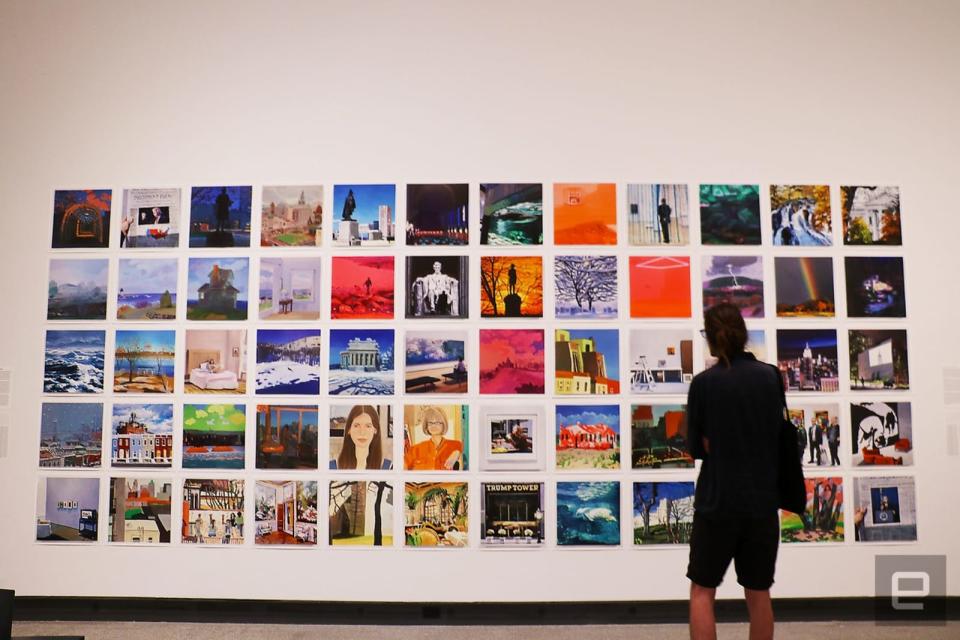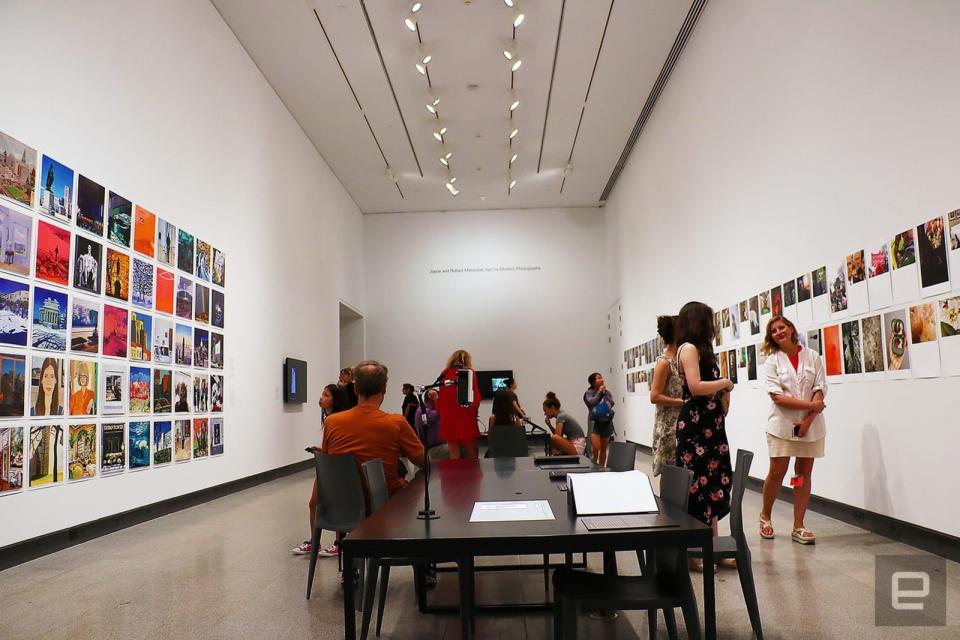The Met's latest exhibit puts oversharing on a pedestal
Smartphone cameras are the new paintbrushes at 'Talking Pictures'.
The rules were simple: For five months, 12 pairs of artists participating in the Metropolitan Museum's Talking Pictures: Camera-Phone Conversations Between Artists exhibit had to use their phones to take and share photos or videos with each other. Texts or captions were not allowed.
A dozen artists were picked to participate; they were then tasked with inviting one fellow artist to be their conversation partners. The project was designed to explore what would happen when, thanks to the instant nature of smartphone photography, artists can create and share their works with "unprecedented intimacy." The exhibit, made possible by Adobe, is open until December 17, 2018, and features multiformat presentations of the dozen resulting conversations.
The participating artists had to upload their media to an iCloud account shared between them and the museum. They weren't allowed to post any of the material to social media. The exhibit's curator and organizer, Mia Fineman, told Engadget they didn't use a messaging app because those tend to compress files. And that's a compromise the Met didn't want to make because some of the prints in this gallery are 19 inches by 19 inches. Although they wanted to create an app to let the artists send each other full-res files, they weren't able to finish one in time for the project.
Because uploading to iCloud isn't the way we typically send each other pictures, the resulting exchanges for Talking Pictures aren't a perfect mimicry of real-world interaction. But they most likely wouldn't have been even if the participants had used iMessage anyway. The artists were all aware from the beginning that their work would eventually be displayed for the world to see, so there was always going to be a limit on how personal they got.

That's not to say the photos at Talking Pictures aren't intimate. Manjari Sharma and Irina Rozovsky started out as acquaintances but grew close over the course of the project after they discovered they were both pregnant and due in April. Their exchange, which is presented as two rows of prints spanning an entire wall in the museum, gets uncomfortably familiar. In addition to stunning nightscapes and snapshots of family members, Sharma and Rozovsky also uploaded pictures of their pregnant, fuzzy bellies, moments during delivery and even their placentas afterward.
Few other conversations got that intimate -- not even between one pair of artists that were actually married to each other. Rob Pruitt and Jonathan Horowitz had a pretty typical dialogue that mostly consisted of pictures of funny signs, political observations and beautiful landscapes. And because this was presented on an iPad that you swipe through, browsing their conversation felt more like scrolling through their Instagram feeds without witty captions, hashtags or likes.
Most of the other interactions feel similarly mundane. Whether they are played on a TV screen or printed out and bound in a voluminous book, the projects feel like a collection of Instagram accounts. In other words, each conversation typically contains pictures that are good on their own, some more impressive than others, but rarely tell a cohesive story or offer meaningful commentary.

Two sets of work stand out, though. Cynthia Daignault and Daniel Heidkamp shared photos of their paintings done specifically for Talking Pictures, usually within days of each other. Their work includes 60 prints (measuring 19x19 inches) of paintings that are 18x18 inches in real life. Each image was shot with an iPhone and is clear enough that clumps of paint looked as if they were actually there. Laid out chronologically in a 12x5 grid, it again reminded me of an Instagram page, albeit one that stuck to the older square-only format.
Each print depicts something you'd typically share on social media -- like serene countrysides or a hand holding up a newspaper. Some of the paintings were even colored to look like they had filters applied, although whether that was deliberate isn't clear. And yet, because the amount of thought and preparation that went into it is abundantly obvious, Daignault and Heidkamp's piece bowls over its audience with skilled, careful execution.

The pair whose pictures delivered the most effective interpretation of the exhibit's message, however, is Christoph Niemann and Nicholas Blechman. Both are talented illustrators (Blechman is the art director at The New Yorker), and their collaboration is presented in a thin, nondescript hardcover book. Flip it open, and you'll see a picture of a hand-drawn black circle with a dotted line that goes over to the next page. Turn over, and that dot has made its way across the next two pages and has become a chicken's egg. On the page after that, a photo shows the next stage in the dot's evolution -- as the back of a real man's head.
The rest of the book plays out the same way -- sketches blending with the real world in a cute, often comical way. Again, it sometimes reminds me of Instagram accounts where people take photos of themselves holding up cutouts of pictures against real-world scenes. But what Niemann and Blechman's work highlights is their ability to use instant sharing to inspire thoughtful, creative responses. For example, in reaction to a photo that Blechman shared of a bush growing through a crack in the pavement, Niemann sketched a smooth-surfaced globe with similar globs peeking out through crevices all over. Even on its own, this back-and-forth stands as a powerful criticism of man's impact on Earth.
Excited to be in a group show at the @metmuseum . Opening 6/27. A visual conversation with @nblechman via smartphone https://t.co/c8vf4zkWjR pic.twitter.com/fwHcK1CJ43
— Christoph Niemann (@abstractsunday) June 23, 2017
When sharing photos is so easy and efficient, the result should be mutual inspiration and growth, not an endless stream of images screaming "look-at-me!" But this is sadly lost on the Instagram and Snapchat generation (which I am, admittedly, a part of). Blechman and Niemann's book (which you can buy from their website) isn't all serious thought-provoking criticism, though: In fact, it offered mostly cheeky, clever perspectives on everyday situations that will make you marvel at the artists' genius.
Like the book, the exhibit ultimately never gets too dark or critical. It could ask questions, like whether smartphone cameras have cheapened modern photography or if our generation is too obsessed with itself. But it doesn't. Instead, it simply celebrates the ways artists were able to wield phones as paintbrushes.
Talking Pictures is a diverse collection of pictorial conversations that showcases the different ways we use our phones. But we already knew that the camera has morphed from a tool to preserve special moments to a window for instant sharing. The exhibit also proves, albeit unintentionally, that it takes careful thought to differentiate the mundane from the meaningful. While you'll enjoy getting an inside look at these artists' lives and points of view, you probably won't leave feeling like you've learned a lesson. And so, Talking Pictures, unfortunately, remains in forgettable, mediocre territory instead of leaving a lasting impact.
































